 |
| Minolta Weathermatic-A |
Some cameras I've bought purely on a whim. The
Minolta Weathermatic-A was one such camera: a waterproof, underwater 110 format camera, listed on a well-known auction site for a mere £5 plus postage - which gained no other bids. When the camera arrived, my initial impression was that it's surprisingly large, large for 110 format: the camera body is 190mm long, around 50mm at its thickest where the knobs and levers are, and 70mm deep. The Weathermatic-A dates from 1980 and Minolta's decision to bring out a waterproof camera for the 110 format probably reflects the growing popularity of scuba diving and other such sports. The camera is waterproof to 5 meters, and as well as its large controls, designed to be easy to use with gloves, there is also an intergral padded wriststrap which can be attached to either right or left side of the camera. The yellow and black colour scheme also denotes its design relationship to diving gear, and a few other companies made waterproof cameras with yellow and black colour schemes around the same time period in the late 1970s and through the 1980s, notably the
Motormarine and the
Aquamatic. The Weathermatic-A wasn't followed by a
Weathermatic-B, but the concept of an amateur underwater camera seems to have been sound enough for Minolta to follow it with the 35mm
Minolta Weathermatic 35 DL (there was also a
Minolta Weathermatic Vectis Zoom for the APS format in the 1990s). Other accessories for the Weathermatic-A included a sports finder, plastic case and belt strap.
 |
| Minolta Weathermatic-A, top view with aperture and focus controls |
The controls are large and simple to use. On the top of the camera are two knobs, one for focus, with a series of symbols to indicate distance, the other, which changes the aperture, has two weather symbols, for sun and cloud and flash. Next to this is the shutter button, a large rubberised pad - not dissimilar to Agfa's orange buttons in their Sensor range. On the underside of the camera is the frame advance lever. The lens is a f3.5 26mm Rokkor, with a close focus distance of 0.9m or 3ft; the shutter is set at 1/200th only.
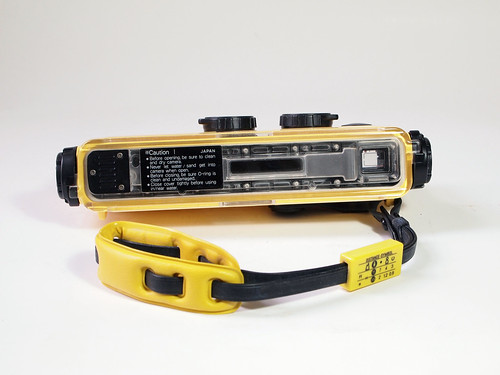 |
| Minolta Weathermatic-A rear view |
The viewfinder indicates the focus setting with a red transparent tab that moves over the same series of distance symbols. There is also a simple parallax indication, and a red underexposure warning. This is powered by a single AA battery, used for both metering and the built-in flash. However the shutter itself is entirely mechanical: I first used the camera without a battery, shooting in daylight with the aperture selector set to 'cloudy'. The Weathermatic-A is sometimes described online as having three aperture settings, but this is more nuanced: the aperture knob can be set to intermediate positions between the two aperture settings, for full sun or cloud, while the flash setting changes the aperture with the
focus setting - as the focus is set closer, the aperture reduces.
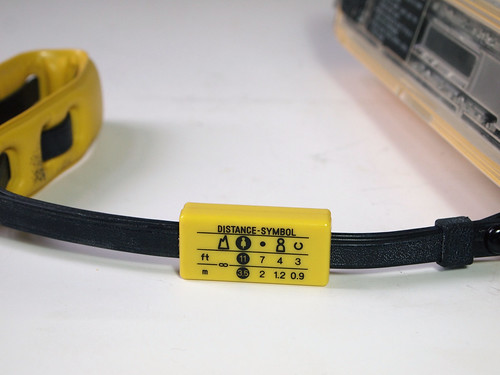 |
| Minolta Weathermatic-A with strap information for focus settings |
Embossed on the underside of the camera body is a numerical key for the distance symbols in both feet and metres, and "actual flash-range on land"; these are also printed on both sides of the strap toggle. The flash distances are given for 100 and 400 ASA film: the camera has the film speed pin to sense either low or high cartridges. On top of the camera, behind the focus and aperture knobs, there's a raised triangle. This might just be a design quirk, but it seems to indicate the film plane: it's in the right place, directly behind the lens, and above the window which shows the cartridge and the frame number on the backing paper of the film.
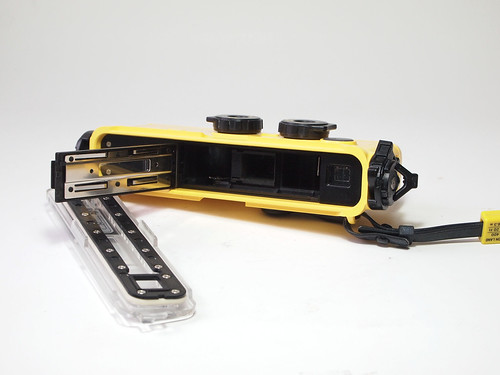 |
| Minolta Weathermatic-A opened for loading |
The camera back has two locks for its rear seal, these have clips that need to be lifted before each lock can be rotated in opposite directions. Inside this, both film and battery can be loaded separately.
For my first tests with the Weathermatic-A, I used 110 cartridges reloaded with double-perforated 16mm Kodak Photo Instrumentation film. The Weathermatic-A is a typical 110 camera in that it needs perforations to function: the shutter release does not work unless the internal pin connects to a perforation. However, unlike some other 110 cameras I've used, the Weathermatic-A's single-stroke lever will advance the film a whole frame - or four standard 16mm perforations - without snagging, with just an odd, occasional overlap.
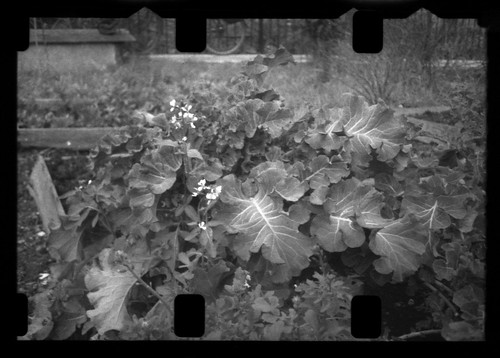 |
| Minolta Weathermatic-A with reloaded Kodak Photo Instrumentation film |
Although I hardly ever use flash, I did test the camera's built in flash unit, seen in the image below, which worked perfectly adequately. There's a small 'flash-ready' LED that shows up on the rear of the camera body to show when the flash is fully charged.
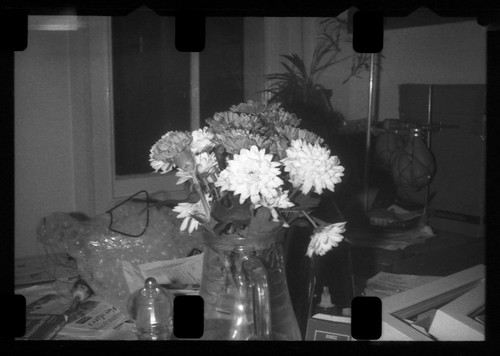 |
| Minolta Weathermatic-A with reloaded Kodak Photo Instrumentation film |
When I made my first tests, I didn't use it underwater, but I did take the camera out on a very rainy day with impunity; to test it was still waterproof, I did submerge the camera in a sink full of water, checking for any air bubbles coming from the body to indicate a leak before using it underwater.
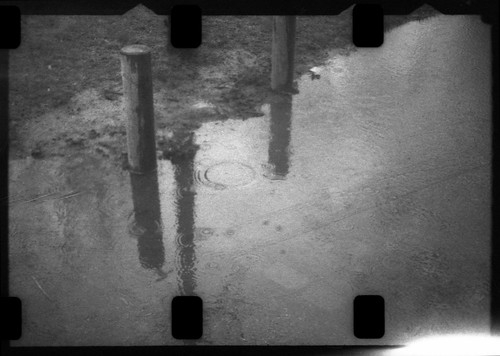 |
| Minolta Weathermatic-A with reloaded Kodak Photo Instrumentation film |
After the first tests made with reloaded 110 cartridges, I later shot a roll of Lomography Orca film while swimming in the sea, testing the camera's waterproof qualities. I also used the Lomography Tiger colour negative film on the same occasion, but only after getting out of the water. I did try a couple of shots underwater, but these were very uninteresting shots of feet in the mud (located at the end of the Thames estuary as the coastline turns, Southend and Shoeburyness, where I shot these films, are very well known for their mud, from the silt carried down the river); in one shot further down this post, I attempted to shoot camera with its lens half submerged.
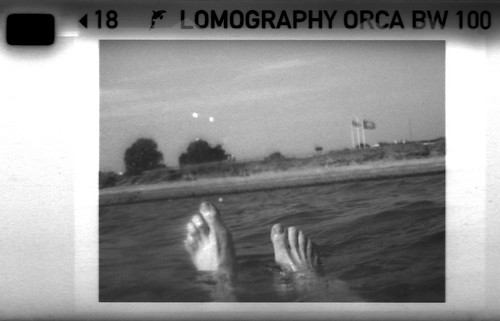 |
| Minolta Weathermatic-A with Lomography Orca film |
As with other 110 cameras, the negative size is significantly larger than the 110 film's pre-exposed mask, as can be seen in both colour and black and white images: one benefit of using reloaded cartridges is to take advantage of the whole negative area, which is admittedly compromised by the perforations themselves. However, it would be possible to crop the frame to its full width for a slightly elongated rectangular image inside the perforations.
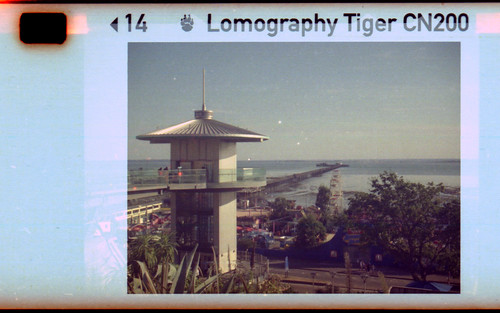 |
| Minolta Weathermatic-A with Lomography Tiger film |
In the photographs using the reloaded cartridges, the frame has a distinct shape with three notches along the top of the frame. At the top left of many frames, there's a mark which appears to be some form of light leak (outside of the 110 printed frames), but its regularity makes it seem like a deliberate marking, although its hard to see what the purpose might be.
 |
| Minolta Weathermatic-A with reloaded Kodak Photo Instrumentation film |
I subsequently used the Weathermatic-A while kayaking, taking a number of films, both cartridges of reloaded Photo Instrumentation film and Lomography Orca, with spare films in a resealable plastic bag to keep them dry. Paddling with the camera strapped to one wrist was not practical, but it could be attached to the life jacket I was wearing in such a way that I could lift it to my eye to shoot while on the river (as I avoided capsizing on this excursion, I didn't actually use the camera
in the water here).
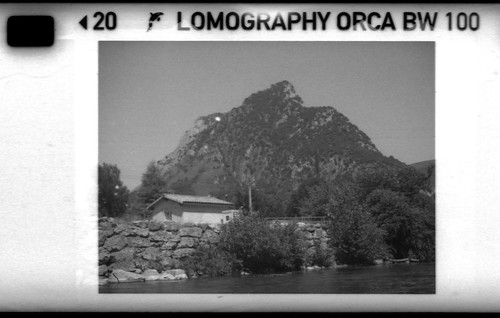 |
| Minolta Weathermatic-A with Lomography Orca film |
In a number of frames, some curious light spots appear in the image area. My first thoughts was that these were caused by water on the lens housing, with the possibility that small droplets might have created this effect by reflecting sunlight into he camera. However, this didn't seem a satisfactory explanation, as some were in shots taken on dry land. When I got the colour negative film developed, there were spots again, but of an orange-red colour. Some
research online showed that these marks are caused by minute holes in the backing paper - and the positioning of these spots does seem to match up with the hole in the back of the cartridge in which the frame numbers appear, rather than across the whole film. Looking back at 110 shots from other cameras did show up these marks on occasion, but rarely - which I think must be determined by the brightness of the light when shooting: it's much less likely to happen when photographing inside and on overcast days as I had done with the
Agfa Optima Pocket Sensor for example. Reusing the cartridges no doubt also causes wear on the backing paper which possibly increases the likelihood of this occurring, but this effect also shows in the new Orca films. Taping over the cartridge window would be one solution, although this means not being able to see how many frame have been shot.
 |
| Minolta Weathermatic-A with Lomography Tiger film |
Other than light leaks from the backing paper, the most common problem I found when shooting the Weathermatic-A was down to user error: the focus knob has a click stop at the 'whole person' icon. This is set to 3.5m or 11ft; as this is the only click stop on the focus knob and is its 'centered' position. I made the mistake of assuming that this might be a hyperfocal distance setting for the 'full sun' aperture at least, which it isn't - resulting in quite a few slightly-out-of-focus frames. Although I've only shot a very limited range of emulsions with the camera, I think the Photo Instrumentation film provides the best results so far; although I don't see it being used regularly, as a camera to take anywhere
wet, the Minolta Weathermatic-A works very well within its intended remit.
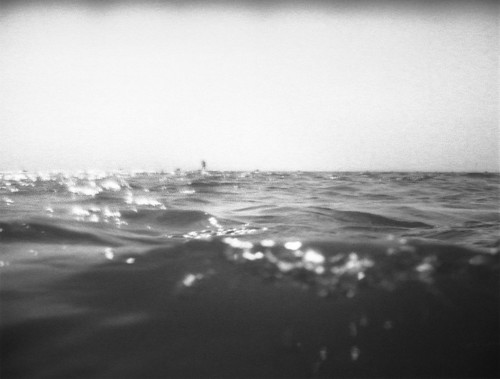 |
| Minolta Weathermatic-A with Lomography Orca film |
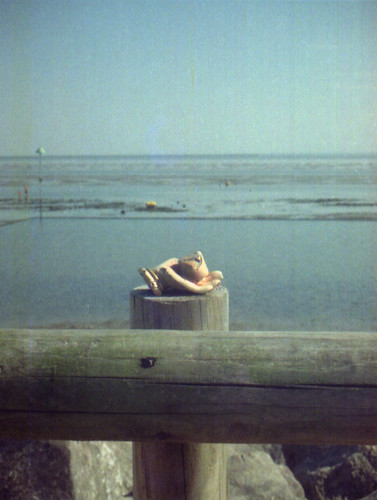 |
| Minolta Weathermatic-A with Lomography Tiger film |
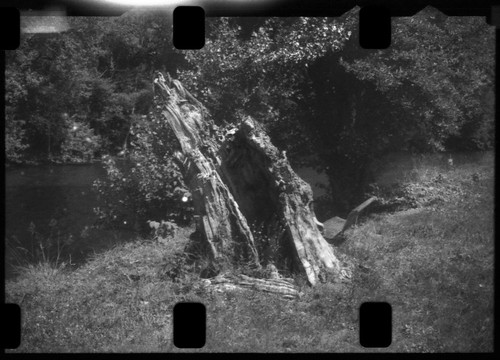 |
| Minolta Weathermatic-A with reloaded Kodak Photo Instrumentation film |
Sources/further reading
Minolta Weathermatic-A on Camera-Wiki
Weathermatic-A on Submin.com
Collection-Appareils page on the Weathermatic-A
Weathermatic-A on Forgotten Charm
Minolta Weathermatic-A manual on Butkus















